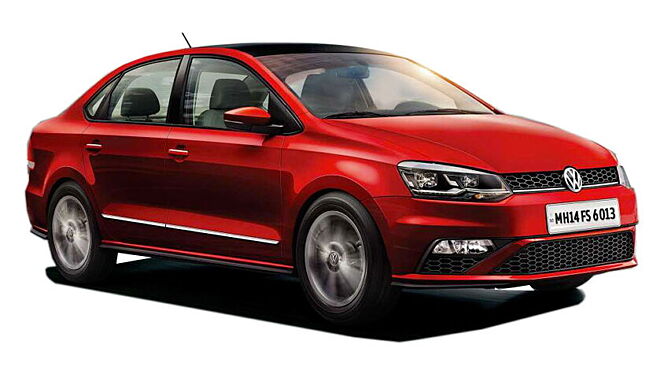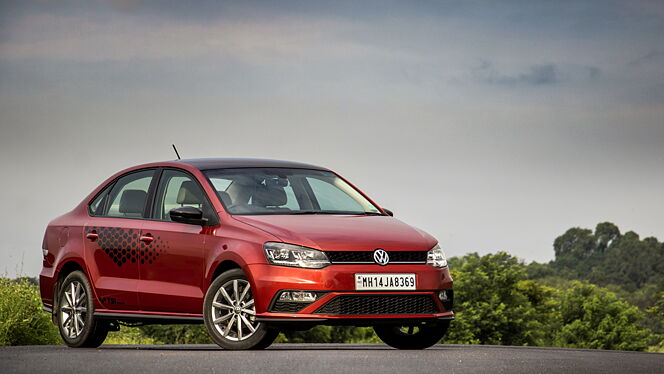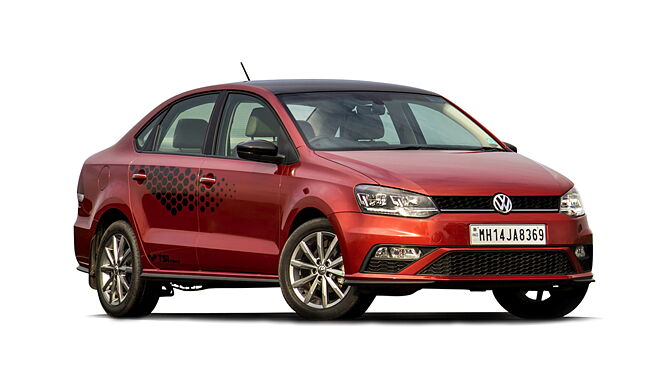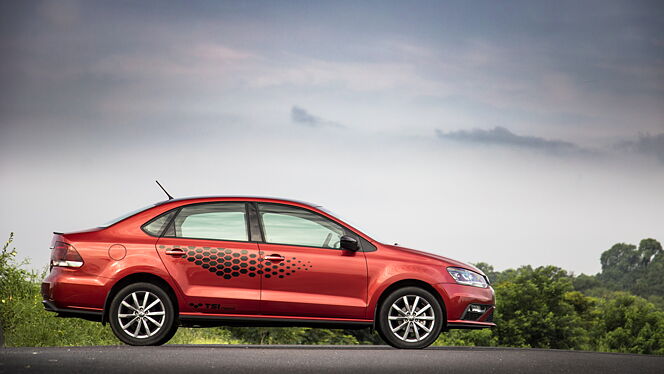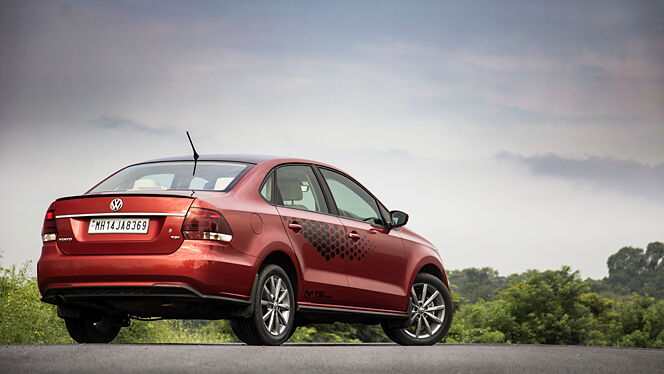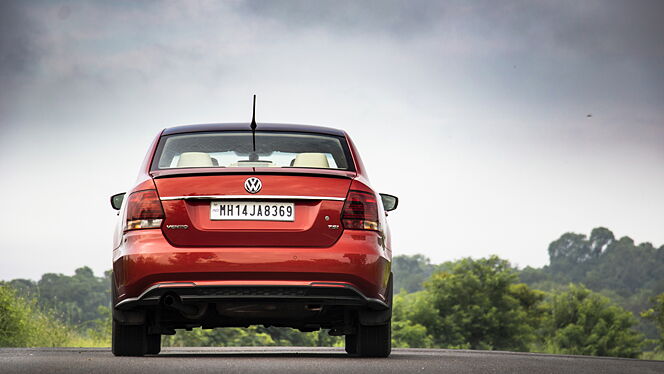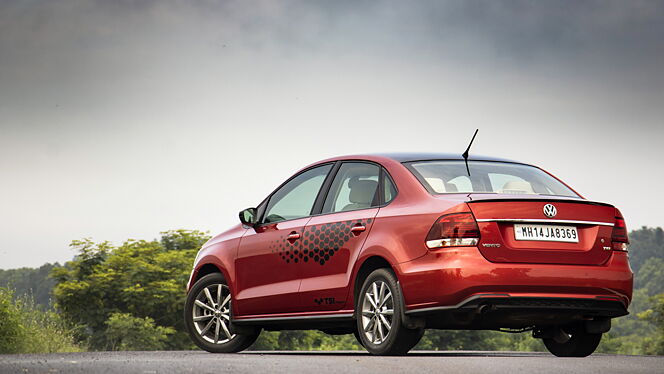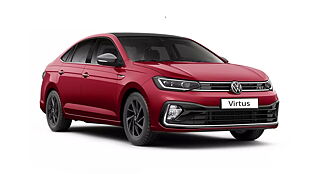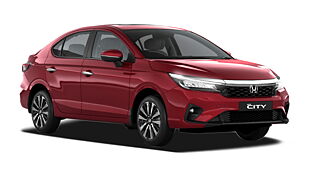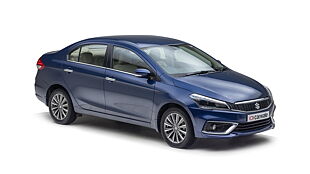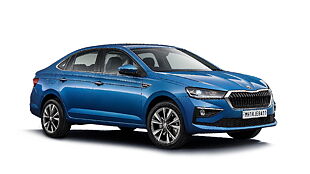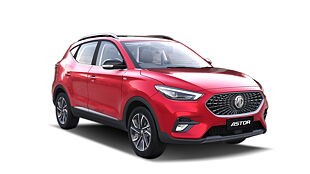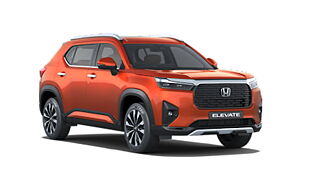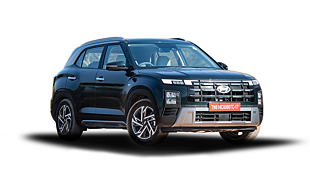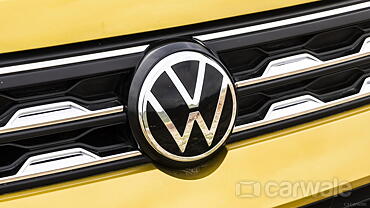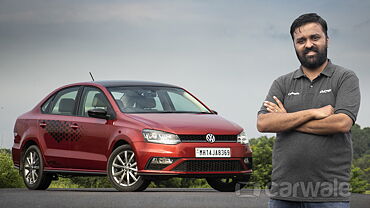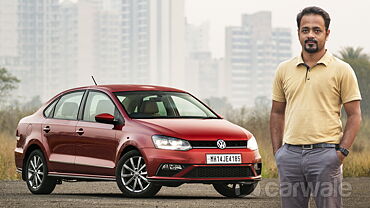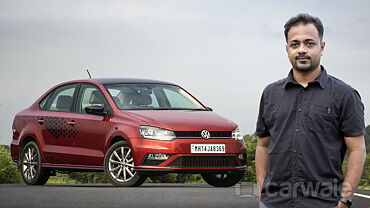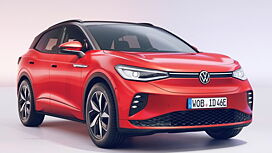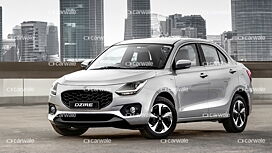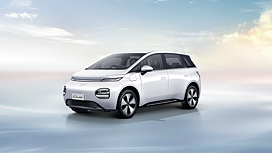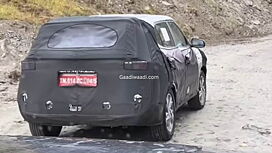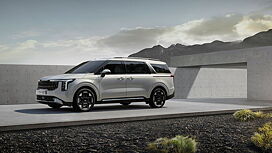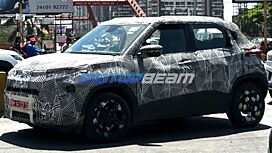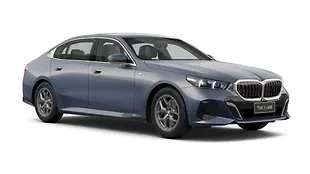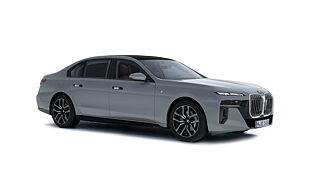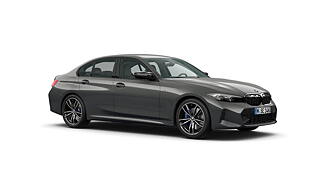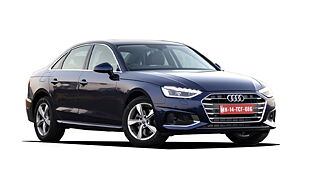Volkswagen Vento
- Overview
- Variants
- Key Specs
- Expert Opinion
- Similar Cars
- Colours
- Brochure
- Mileage
- User Reviews
- News
- Expert Reviews
- Videos
- Images
- FAQs
Variant
Explore Used Volkswagen Vento
Similar New Cars
Vento Price List in India (Variants)
| Variants | Last Recorded Price | Compare |
|---|---|---|
999 cc, Petrol, Manual, 17.69 kmpl, 109 bhp | Rs. 8.69 Lakh | Show price in my cityGet Offers |
1598 cc, Petrol, Manual, 16.09 kmpl, 103 bhp | Rs. 8.81 Lakh | Show price in my cityGet Offers |
999 cc, Petrol, Manual, 17.69 kmpl, 109 bhp | Rs. 9.14 Lakh | Show price in my cityGet Offers |
1498 cc, Diesel, Manual, 22.27 kmpl, 108 bhp | Rs. 9.63 Lakh | Show price in my cityGet Offers |
1598 cc, Petrol, Manual, 16.09 kmpl, 103 bhp | Rs. 9.99 Lakh | Show price in my cityGet Offers |
1498 cc, Diesel, Manual, 22.27 kmpl, 108 bhp | Rs. 9.99 Lakh | Show price in my cityGet Offers |
1598 cc, Petrol, Manual, 16.09 kmpl, 103 bhp | Rs. 10.00 Lakh | Show price in my cityGet Offers |
999 cc, Petrol, Manual, 17.69 kmpl, 109 bhp | Rs. 10.00 Lakh | Show price in my cityGet Offers |
999 cc, Petrol, Manual, 17.69 kmpl, 109 bhp | Rs. 10.00 Lakh | Show price in my cityGet Offers |
999 cc, Petrol, Manual, 17.6 kmpl, 109 bhp | Rs. 10.00 Lakh | Show price in my cityGet Offers |
999 cc, Petrol, Manual, 17.69 kmpl, 109 bhp | Rs. 10.99 Lakh | Show price in my cityGet Offers |
999 cc, Petrol, Automatic (TC), 17.69 kmpl, 109 bhp | Rs. 11.49 Lakh | Show price in my cityGet Offers |
1197 cc, Petrol, Automatic, 18.19 kmpl, 103 bhp | Rs. 11.98 Lakh | Show price in my cityGet Offers |
1498 cc, Diesel, Manual, 22.27 kmpl, 108 bhp | Rs. 12.09 Lakh | Show price in my cityGet Offers |
999 cc, Petrol, Automatic (TC), 16.3 kmpl, 109 bhp | Rs. 12.99 Lakh | Show price in my cityGet Offers |
999 cc, Petrol, Manual, 17.69 kmpl, 109 bhp | Rs. 13.05 Lakh | Show price in my cityGet Offers |
1197 cc, Petrol, Automatic, 18.19 kmpl, 103 bhp | Rs. 13.18 Lakh | Show price in my cityGet Offers |
1197 cc, Petrol, Automatic, 18.19 kmpl, 103 bhp | Rs. 13.18 Lakh | Show price in my cityGet Offers |
1498 cc, Diesel, Automatic, 22.15 kmpl, 108 bhp | Rs. 13.36 Lakh | Show price in my cityGet Offers |
999 cc, Petrol, Automatic (TC), 16.35 kmpl, 109 bhp | Rs. 13.37 Lakh | Show price in my cityGet Offers |
999 cc, Petrol, Automatic (TC), 16.3 kmpl, 109 bhp | Rs. 14.42 Lakh | Show price in my cityGet Offers |
1498 cc, Diesel, Automatic, 22.15 kmpl, 108 bhp | Rs. 14.49 Lakh | Show price in my cityGet Offers |
1498 cc, Diesel, Automatic, 22.15 kmpl, 108 bhp | Rs. 14.50 Lakh | Show price in my cityGet Offers |
999 cc, Petrol, Automatic (TC), 16.35 kmpl, 109 bhp | Rs. 14.79 Lakh | Show price in my cityGet Offers |
Volkswagen Vento Car Specifications
| Price | Rs. 8.69 Lakh onwards |
| Mileage | 16.09 to 22.27 kmpl |
| Engine | 1197 cc, 1498 cc, 1598 cc & 999 cc |
| Safety | 4 Star (Global NCAP) |
| Fuel Type | Petrol & Diesel |
| Transmission | Manual & Automatic |
| Seating Capacity | 5 Seater |
Volkswagen Vento Summary
Volkswagen Vento Price:
Volkswagen Vento price starts at Rs. 8.69 Lakh and goes upto Rs. 14.79 Lakh. The price of Petrol variant for Vento ranges between Rs. 8.69 Lakh - Rs. 14.79 Lakh and the price of Diesel variant for Vento ranges between Rs. 9.63 Lakh - Rs. 14.50 Lakh.Volkswagen Vento Variants:
Vento is available in 24 variants. Out of these 24 variants, 13 are Manual, 5 are Automatic (TC) and 6 are Automatic.Volkswagen Vento Colours:
Vento is offered in 6 colours: Sunset Red, Reflex Silver, Candy White, Carbon Steel, Toffee Brown and Lapiz Blue. However, some of these colours are available in specific variants.Volkswagen Vento Competitors:
Vento is competing against Volkswagen Virtus, Honda City, Maruti Suzuki Ciaz, Skoda Slavia, Hyundai Verna, MG Astor, Honda Elevate, Hyundai Creta and Skoda Kushaq.How is the Volkswagen Vento car?
Pros
- Fun, easy to drive
- Peppy engine
Cons
- Rivals offer more space
- Ageing design
Volkswagen Vento Verdict
The Volkswagen Vento has aged well despite having a dated design and lacking the extravagance that new-age sedans offer. And, it still scores high for being a well-built car and offering rock-solid German build quality with excellent on-road dynamics. Now, the new torque-converter gearbox continues to offer the convenience that buyers in this segment look for.
Volkswagen Vento Car Review
Engines and Performance
7.5
Ride and Handling
7.5
Interior Space and Quality
7
Features and Safety
6.5
Conclusion
7
Brochure of Volkswagen Vento
Volkswagen Vento Colours
Volkswagen Vento is available/sold in the following colours in India.
Volkswagen Vento Mileage
Volkswagen Vento mileage claimed by ARAI is 16.09 to 22.27 kmpl. The petrol variant has a mileage of 16.09 to 18.19 kmpl. The diesel variant has a mileage of 22.15 to 22.27 kmpl.
| Powertrain | ARAI Mileage | User Reported Mileage |
|---|---|---|
| Petrol - Manual (999 cc) | 17.68 kmpl | 18 kmpl |
| Petrol - Manual (1598 cc) | 16.09 kmpl | - |
| Diesel - Manual (1498 cc) | 22.27 kmpl | - |
| Petrol - Automatic (TC) (999 cc) | 16.6 kmpl | 18 kmpl |
| Petrol - Automatic (1197 cc) | 18.19 kmpl | - |
| Diesel - Automatic (1498 cc) | 22.15 kmpl | - |
Volkswagen Vento User Reviews
- Vento
- Vento [2015-2019]
4.7/5
Exterior
Comfort
Performance
Fuel Economy
Value For Money
- A robust & a trouble free CarAfter lot of test drives I have chosen Volkswagen Vento Tsi Highline plus as my car in 2021 and drove around 22,000 Km happily. Initially I had a feeling that the mileage is too low between 11 to 14 Km on an average but after first service in 15000 Km my Vento gave me 18 + Km/litre and I am pretty confident that it will give better mileage than most of the sedans available in the current lineup. The claimed mileage of 18.6 is on the main central road in Kerala against mild traffic and speed ranged between 40 to 80 Km/h.Rating parameters(out of 5)5
Exterior
5Comfort
5Performance
5Fuel Economy
5Value For Money
About the ReviewerPurchase NewDriven forFew thousand kilometersRead MoreWas this review helpful?50 - Volkswagen Vento Highline Plus reviewBest car for families and for long drives with long boot space and cabin space seats are ventilated .and driving experience is awesome on highways . mileage is very good . service is also very good .don't think that Volkswagen services are very expensive that's just an rumor .Rating parameters(out of 5)5
Exterior
5Comfort
5Performance
5Fuel Economy
5Value For Money
About the ReviewerPurchase NewDriven forFew thousand kilometersRead MoreWas this review helpful?74 - Best car in this segmentCar is Amazing, value for money, luxury car, great pickup, driving experience is amazing. Drove it for 1000 KM the mileage is a little low, but to be honest your family will be safe inside it.Rating parameters(out of 5)5
Exterior
5Comfort
5Performance
3Fuel Economy
5Value For Money
About the ReviewerPurchase NewDriven forFew hundred kilometersRead MoreWas this review helpful?32 - Fabulous luxury ride qualityIt's a fantastic sedan under 15 lakhs, feels like luxury premium car, steering is like Mercedes that's very impressive. I have seen Ciaz, City, Verna but ride stability of Vento is so good. Interior feels like luxury.(2022 production Vento) Interior design and quality doesn't match with other sedans under 15 lakhs.Rating parameters(out of 5)5
Exterior
5Comfort
5Performance
5Fuel Economy
5Value For Money
About the ReviewerPurchase NewDriven forFew hundred kilometersRead MoreWas this review helpful?21 - Volkswagen Vento Highline Plus reviewDriving experience is fabulous Only few changes in this car but not look old in the market this is called German beauty Service is slightly expensive but performance is top notch Average of the car is 16 to 18 and I am happy with it.Rating parameters(out of 5)5
Exterior
5Comfort
5Performance
5Fuel Economy
5Value For Money
About the ReviewerPurchase NewDriven forFew thousand kilometersRead MoreWas this review helpful?53
4.2/5
Exterior
Comfort
Performance
Fuel Economy
Value For Money
- Emission Norms BS-III / BS-IV??Only ONE point is bothering me - the Emission Norms of the Vento TSI 1.2 HL (2015 model). Can anyone confirm whether this car is BS-IV? I can't find a single document from VW / Dealer that supports this claim. Recently, during a PUC check, the vendor categorically told me that my car is BS-III, now that came as a BIG surprise!!!! I also have a Polo GT TSI (2021 model) -- here too I couldn't find a single document that supports the claim that it has a BS-VI engine.!!!Rating parameters(out of 5)5
Exterior
5Comfort
5Performance
5Fuel Economy
5Value For Money
About the ReviewerPurchase NewDriven forIts my mate since agesRead MoreWas this review helpful?00 - Luxury and comfort on WHEELSI changed from Polo, special edition, Breeze to Vento All star in fag end of Dec.2017, at Visakhapatnam, from Mody Auto. Over all my experience has been pleasant with respect to the dealer reception, explanation, test drive, warmth and even service center staff. All this two years and odd, the vehicle performance has been good w.r.t engine and I am very happy w.r.t the suspensions. Very comfortable for a vehicle in this range, which I checked. However the cons with this is it's mileage. Though 16.19 KMPL, I've never got more than 12.7 KMPL in city limits. I travel 21 Km every day. The service persons only give reasons or teach me to drive but are unable to help me in this regard. One funny reason they give is that quick or instant acceleration should not be given and allow the baby to pick the speed at it's own time, so as to achieve the desired mileage. In long distance also, it did not give me atleast 15 KMPL. As on date the car covered 24,000 + KMs. zAm very unhappy with this, when compared to other vehicles in the range. Secondly, the car paint, though it is good, but forms line even when we wipe with a cloth. Ofcourse it goes off when wiped again. But a touch of finger nail, a normal movement of hand nails by a kid while passing beside the car, leaves an impression which does not go and we have to live with such scratches. Thirdly, squeeking or rattle sounds at times in the cabin while moving on uneven surface at low speeds, may be because of the PVC finishes or so (not from body). However, I felt that I have not got a perfect or proper piece after driving another vento, purchased by my known person at my recommendation. Otherwise it is really good.Rating parameters(out of 5)5
Exterior
5Comfort
4Performance
2Fuel Economy
4Value For Money
About the ReviewerPurchase NewDriven forFew thousand kilometersRead MoreWas this review helpful?00 - DSG Gearbox will blow your mind :) :) :)1. Buying a car at Volkswagen showroom, Wakad, Pune was an amazing experience. I selected the purchase date two weeks after the booking and got the car on the same day. though the showroom was closed for others...One of the sales manager (Rakesh) opened the showroom just to give me the delivery of my car. 2. I am riding this car from 7 months and I am very happy till now. 3. If you talk about looks, Looks of Volkswagen cars are not always a sporty or stylish if you compare these cars with Hyundai but looks are very decent no too funky but very decent. 4. The best Experience of the Automatic is DSG gearbox and that too here comes along with 1.5 TDI turbocharged diesel engine. This is really magic for the ones who love driving. even fuel economy is best in class, In city : 14 - 16 Km/Ltr. On Highways: always more than 20. I even recorded 23.5 on my trip to Lonavala. 5: Volkswagen cars have yearly servicing and I don't have a servicing experience for my car till now. Pros: - If you enjoy driving then this 1.5 TDI turbocharged engine will make you crazy... - Comfort and safety 5 stars for this. Cons: - Looks (I am happy though some people will make this point. so added this one in cons) - The sunroof is missing.Rating parameters(out of 5)4
Exterior
4Comfort
5Performance
5Fuel Economy
5Value For Money
About the ReviewerPurchase NewDriven forFew thousand kilometersRead MoreWas this review helpful?00 - AttractiveNo buying experience. Smooth and comfortable riding. stylish look. Top performance.servicing and maintenance cost are affordable. very comfortable space. Require good radius to turn. Needed more space to park.Rating parameters(out of 5)5
Exterior
5Comfort
5Performance
4Fuel Economy
5Value For Money
About the ReviewerPurchase Not PurchasedDriven forDid a short drive onceRead MoreWas this review helpful?00 - My second loveThe dealer ms Shree Bharat motors pahal, bbsr was good but the staff dealing me was not much professional and educated about the vehicle. Look of the vehicle is a class appart, feels a true mate Performance is very good , as it's a brilliant engine. If u want power then it ll give and if you want a mileage then drive softly n it will give up to 19kmpl Service is charged more and you need to be educated about the vehicle otherwise these service mechanics will charge more without putting any extra effort. VW should look into this . In my case they have changed my oil drainage screw at a cost of 200 while it's unnecessary.very lazy People n they will eat full day for a first service of the vehicle. Pathetic service. Well every vehicle has its pros n cons. But cons can't be on a heavier side as compared to pros as I love it. I would suggest enquiring about the service at your locality before going for it. Thank u Reg DeepakRating parameters(out of 5)5
Exterior
4Comfort
5Performance
5Fuel Economy
5Value For Money
About the ReviewerPurchase NewDriven forFew thousand kilometersRead MoreWas this review helpful?00
Volkswagen Vento News
Volkswagen Vento Expert Reviews
Volkswagen Vento Videos
Vento Images
FAQs About Volkswagen Vento
Popular Upcoming Cars
Popular Sedan Cars
- Home
- Volkswagen Cars
- Vento



